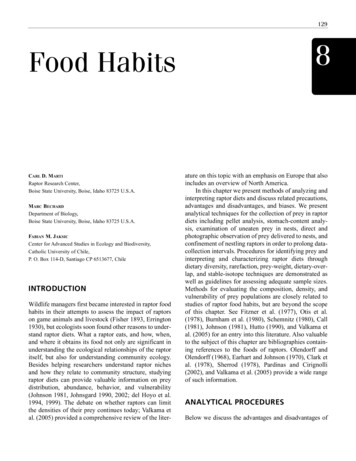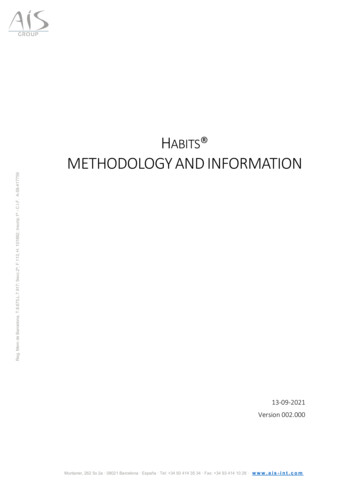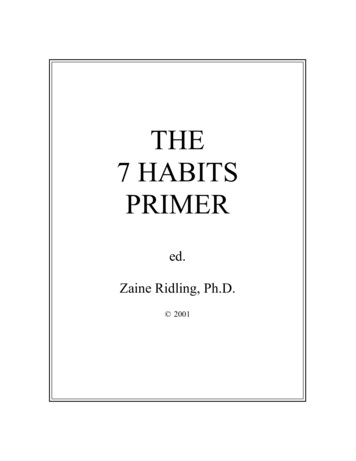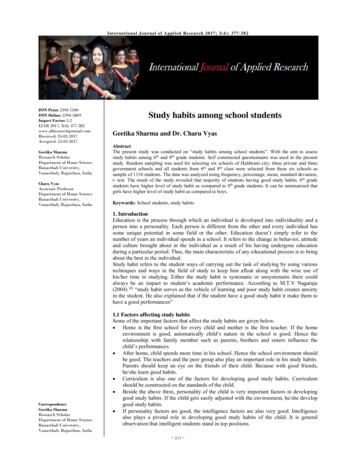
Transcription
1298Food HabitsCARL D. MARTIRaptor Research Center,Boise State University, Boise, Idaho 83725 U.S.A.MARC BECHARDDepartment of Biology,Boise State University, Boise, Idaho 83725 U.S.A.FABIAN M. JAKSICCenter for Advanced Studies in Ecology and Biodiversity,Catholic University of Chile,P. O. Box 114-D, Santiago CP 6513677, ChileINTRODUCTIONWildlife managers first became interested in raptor foodhabits in their attempts to assess the impact of raptorson game animals and livestock (Fisher 1893, Errington1930), but ecologists soon found other reasons to understand raptor diets. What a raptor eats, and how, when,and where it obtains its food not only are significant inunderstanding the ecological relationships of the raptoritself, but also for understanding community ecology.Besides helping researchers understand raptor nichesand how they relate to community structure, studyingraptor diets can provide valuable information on preydistribution, abundance, behavior, and vulnerability(Johnson 1981, Johnsgard 1990, 2002; del Hoyo et al.1994, 1999). The debate on whether raptors can limitthe densities of their prey continues today; Valkama etal. (2005) provided a comprehensive review of the liter-ature on this topic with an emphasis on Europe that alsoincludes an overview of North America.In this chapter we present methods of analyzing andinterpreting raptor diets and discuss related precautions,advantages and disadvantages, and biases. We presentanalytical techniques for the collection of prey in raptordiets including pellet analysis, stomach-content analysis, examination of uneaten prey in nests, direct andphotographic observation of prey delivered to nests, andconfinement of nestling raptors in order to prolong datacollection intervals. Procedures for identifying prey andinterpreting and characterizing raptor diets throughdietary diversity, rarefaction, prey-weight, dietary-overlap, and stable-isotope techniques are demonstrated aswell as guidelines for assessing adequate sample sizes.Methods for evaluating the composition, density, andvulnerability of prey populations are closely related tostudies of raptor food habits, but are beyond the scopeof this chapter. See Fitzner et al. (1977), Otis et al.(1978), Burnham et al. (1980), Schemnitz (1980), Call(1981), Johnson (1981), Hutto (1990), and Valkama etal. (2005) for an entry into this literature. Also valuableto the subject of this chapter are bibliographies containing references to the foods of raptors. Olendorff andOlendorff (1968), Earhart and Johnson (1970), Clark etal. (1978), Sherrod (1978), Pardinas and Cirignolli(2002), and Valkama et al. (2005) provide a wide rangeof such information.ANALYTICAL PROCEDURESBelow we discuss the advantages and disadvantages of
130FOOD HABITSeach technique as a guide to its selection for a particularquestion. Regardless of the method selected, sampling isa very important consideration in food-habits studies;inadequate samples can produce misleading conclusions(Errington 1932). Information should be collected frommore than one bird, nest, and, depending on the studyobjectives, more than one season or year (Korpimäki etal. 1994). Non-representative food-habits data may beobtained if the sample size is too small, if a prey speciesis locally or temporarily abundant (e.g., during a population irruption), or if an individual or pair specializes oncertain prey (i.e., behaves idiosyncratically).Despite its importance, determining the adequatesample size prior to beginning a study may be difficult.Valid descriptions of diets that have a high variability inprey require more and larger samples than descriptionsof diets with homogeneity of prey. Studies of seasonalchanges in diet and inter- or intra-population dietaryvariation also require more samples. Investigators mustask whether it is important to document even those preyspecies eaten in very small proportions of the diet orwhether it is more important to know which species arethe mainstays of the raptor’s diet, either numerically orby biomass. The answers to these questions will dependupon study objectives. See Morrison (1988) and Gotelliand Colwell (2001) and below for discussions on quantifying, evaluating, and justifying the size and nature ofdata sets, and Eckblad (1991) for general help on determining how many samples must be taken in biologicalstudies, and our simulations included below relatingsample size with dietary diversity and richness. Otherstatistical considerations are vital as well, and are similar to those in most biological situations (Sokal andRohlf 1995).Regurgitated Pellet AnalysisMost raptors, the Osprey (Pandion haliaetus) being anotable exception, produce pellets consisting of the lessdigestible remains of their prey including bones, teeth,scales, hair, feathers, keratin, and chitin. These materials are compacted by the stomach and regurgitated, usually daily. Identification of remains in pellets can provide both qualitative and quantitative information aboutthe diet of a raptor. Although this method has been usedfor more than a century (Fisher 1893), Errington’s(1930, 1932) extensive studies on raptor feeding didmuch to promote its use. Some early critics dismissedthe technique of pellet analysis entirely (Brooks 1929),but it is now widely accepted as valid for most species.In general, pellet analysis is most reliable for owls(Errington 1932, Glading et al. 1943), and is generallyless reliable for falconiforms because many of the latterspecies dismember prey prior to swallowing and maynot ingest all portions (Craighead and Craighead 1956,Cade 1982). Falconiforms also digest bone to a greaterextent than do owls (Duke et al. 1975, Cummings et al.1976). Owls tend to swallow prey whole or in large portions, with less rejection of identifiable remains (Errington 1932, Duke et al. 1975). Errington (1932) believedthat only young owls digested bones significantly, butRaczynski and Ruprecht (1974) and Lowe (1980)reported considerable bone loss attributed to digestionin adults; neither study, however, provided enoughdetails on the analytical procedures to allow evaluationof accuracy. Others have reported that not all food fedto captive owls was represented in pellets (Errington1932, Glading et al. 1943, Southern 1969). Nevertheless, Mikkola (1983) found very close correlationbetween food eaten and remains in pellets, and Duke etal. (1975) and Cummings et al. (1976) indicated thatvery little, if any, bone digestion occurs in owls.Insectivorous raptors present a different problem.Even though the entire prey is usually swallowed, chitinous portions may be broken into small fragments thatare difficult to identify. Chitin digestion, however,appears to be slight at least in American Kestrels (Falcosparverius) and Eastern Screech Owls (Megascopsasio) (Akaki and Duke 1999).Pellets containing remains of prey too large for asingle meal (e.g., rabbits or hares eaten by eagles, largebuteos, or owls in the genus Bubo) pose a problem ofquantification. Did the raptor feed once on a large preyitem and leave a portion, with the result that remains ina pellet represent only a part of the prey? Or, did theraptor return later and consume the rest, so that all ormost of the identifiable remains are in several pellets?Evidence shows that some raptors do return to largekills for several meals (Bowles 1916, Brown andAmadon 1968), but the number of larger prey specieseaten may be greatly underestimated when pellet analysis alone is used to determine food habits. Large preyitems brought to nestlings have a greater chance ofbeing consumed totally. The remains may be distributedin pellets of several siblings and, in some cases, those ofthe adults as well (Bond 1936, Collopy 1983a).The most profitable strategy for collecting pellets isto search nest sites and roosts. Larger samples can beobtained, species of raptor verified, and seasonal oryearly trends in prey consumption both determined
FOOD HABITSfrom serial collections at the same site. Accumulation ofdata by this method is not uniformly successful with allraptors. Some species remain at one roost for long periods (e.g., Barn Owl [Tyto alba] and Long-eared Owl[Asio otus]), facilitating the collection of a large numberof pellets (Marks and Marti 1984). However, manyother species regurgitate their pellets over wide areas(e.g., Northern Harrier [Circus cyaneus] and Shorteared Owl [A. flammeus]), making collection of an adequate sample difficult (Errington 1932, Craighead andCraighead 1956, Southern 1969, Ziesemer 1981). It isimportant for statistical testing to collect pellets at asmany nests, roosts, or both as possible to reduce problems associated with the lack of independent sampling.Pellets of some species are distinctive in size andshape, but many are not. Guides to pellet identificationfor owl species are available (Wilson 1938, Burton1984), but no method is foolproof for separating pelletsof different species by appearance alone. To ensure thatpellets are identified to species, only fresh pelletsshould be collected at nests, roosts, and perches knownto be occupied by the raptor under study. The same nestsites often are used by different species at differenttimes, so all old material should be removed and discarded prior to collecting new pellets for study.Food-habits data are most valuable when theapproximate date of deposition is known; hence, theknowledge of how long pellets persist in the wild isimportant. Moisture, invertebrates, and fungi rapidlybreak down pellets in exposed situations (Philips andDindall 1979); most pellets in open environmentsdecompose in less than 1 year (Wilson 1938, Fairley1967, Marti 1974). In protected places, such as cavities,caves, or buildings, they may last much longer. Experiments to determine the rate of pellet decay in the localarea of study might be necessary if there is doubt abouthow long pellets persist.The method selected for pellet dissection dependsupon the number of pellets to be analyzed and theobjectives of the analysis. If the quantity is small or ifthe objective is to obtain immediate practical management information (e.g., to determine the principal foodof a raptor or its impact upon a certain species of prey),pellets may be dissected individually by hand. Hair andfeathers are teased away from bones, teeth, and otheridentifiable remains. Forceps and a dissecting needleare helpful aids for this. If quantities of pellets are large,or if better resolution of diet is required, hard remainsshould be separated from hair and feathers more carefully. This can be done by soaking and washing pellets131with water. A more effective technique is to dissolvehair and feathers with sodium hydroxide (Schueler1972). A modification of this procedure works well: dissolve 100 ml of NaOH crystals in 1 l of water, and thencombine a sample of pellets with two to three times asmuch of this solution by volume. Two to four hours ofsoaking with occasional gentle stirring will sufficientlydissolve hair so that washing the solution through ascreen (1/4 in mesh [6.35 mm]) will completely free thebones. Washing should be done over a pan to catch anyfragments that pass through the screen, and the residuecan then be washed, decanted, and added to the sample.Even very small, delicate bones are unharmed by thisprocess, and the likelihood of finding smaller fragmentsis much greater than with dry dissection of pellets. Pellets must not be left in the NaOH solution more than 4hours because teeth may become dislodged, reducingthe chance of specific identification of mammalian preyremains. Chitinous materials also are unaffected byNaOH and are easily recovered, but any hair or featherswill be dissolved. Thus, this technique should not beused if the intent is to identify prey by the use of hair orfeathers.Skulls and dentaries are the most useful remains foridentifying and counting mammalian prey, and a handlens or low-power dissecting scope will be necessary inmany cases to examine these prey remains. Limb bonesand pelvic girdles also are helpful, especially for counting larger prey. Keys may aid in identifying small mammals (Stains 1959, Glass 1973, DeBlase and Martin1974). Reference collections and investigator experience, though, usually are better than keys because skullsin pellets often are broken and may be missing diagnostic parts needed by keys. Thus, side-by-side comparisonwith skulls from reference collections is preferred.Mammalian hair from pellets also may be used to identify prey from raptors that digest bone or do not swallow it. Hair has little value however, for quantifying theprey consumed. Adorjan and Kolenosky (1969) andMoore et al. (1974) developed keys for identifyingmammalian hair, and Korschgen (1980) gives instructions for preparing reference slides for hair. Feathers inpellets create similar but even greater problems thanhairs. Feathers recovered from pellets typically requirecleaning before they can be identified. Sabo and Laybourne (1994) provide techniques for feather preparation and also clues useful in identifying individualfeathers.Small mammals usually are enumerated in pelletsamples by counting skulls and considering dentaries
132FOOD HABITSand leg bones as a backup, especially if decapitation ofprey is suspected. For larger mammal species, fragments should be assembled from a sample (skulls, dentaries, pelvic bones, and heads of limb bones) and thenpieced together to estimate how many individuals wereconsumed (see Mollhagen et al. [1972] for moredetails). This procedure assumes that all parts of theprey were eaten and that all pellets containing theremains were recovered. Thus, counts based on thismethod most likely will be conservative. If possible, anadditional technique should be used as a check.Identifying bird prey is possible from feathers,beaks, and feet but often is difficult to accomplish without a large reference collection. Skulls, sterna, and synsacra are most useful for counting birds in pellets.Experts with access to extensive reference collectionsmay be able to identify bone fragments and individualfeathers to genus or species.Bones of amphibians and bones and scales of fishand reptiles should be retained for identification. Collections of fish opercula at and around nests have been usedto identify the prey of Osprey (Newsome 1977, Prevost1977, Van Daele and Van Daele 1982). Comparison withreference material and consultation with experts on thesetaxa are recommended for identification.Insects and other invertebrate prey also pose problems. The exoskeleton of arthropods is the only portionnot digested by raptors, but often it is highly fragmented, making keys of little value as identification aids.Again, a good reference collection and consultationwith experts are the best approaches to identifying thoseremains.Pellet analysis offers advantages over other techniques—a large sample often may be acquired with relatively little expense, time, or disturbance of the raptors, and both seasonal and yearly trends in diet can beobtained, often from the same birds. Disadvantages arethat pellets of some raptors, particularly falconiforms,do not always contain remains of a significant portionof prey eaten. For this reason, less confidence is possible from analysis of most falconiform pellets and frompellets of large owls preying on large prey. Availableevidence indicates that pellet analysis is an excellenttechnique for medium-sized and smaller owls, e.g.,Boreal Owl (Aegolius funereus) (Korpimäki 1988) andEurasian Pygmy Owl (Glaucidium passerinum) (Kellomäki 1977), but slightly less reliable for insectivorousowls, e.g., Burrowing Owl (Athene cunicularia) andFlammulated Owl (Otus flammeolus), because theirprey remains may be very small and pellets consistingof insect parts decompose rapidly (Marti 1974). Pelletanalysis also appears to be a good method to study dietvariation of Common Kestrels (Falco tinnunculus)using small rodents as their main foods, but also including many insects as alternative prey (Korpimäki 1985,Itämies and Korpimäki 1987). Although some investigations of falconiform diets have used pellet analysisexclusively (see references in Sherrod 1978), we recommend that a second method be used to check theaccuracy of data from pellet analysis. On the otherhand, Ritchie (1982) recommended using pellet analysis to complement studies based primarily upon preyremains in nests.Contents of the Digestive SystemMost early studies of raptor food habits were basedupon examination of prey remains in raptor stomachs(Fisher 1893, McAtee 1935). This technique has noplace in modern research or management practiceexcept where a source of dead raptors, such as roadkills, is available. Killing enough raptors to obtain asample size sufficient to characterize diet is highlyundesirable because the populations of most raptors arerelatively small. The quantity of data obtained from anindividual raptor using this technique is minimal compared with all the other available methods. The procedure for stomach analysis is simply to open the stomachs and crops of dead raptors and examine the contents. Identification and quantification of prey are similar to the processes described under pellet analysis. Ifanalysis cannot be done immediately, stomachs can befrozen or preserved in 10% formalin until examined(Korschgen 1980).If it is essential to examine stomach contents of liveraptors, an emetic technique should be considered(Tomback 1975). Pulin and Lefebvre (1995) employedan antimony potassium tartrate (tartar emetic) on 137bird species from 29 families. This technique apparently has not been tried on raptors and its safety is notknown. Rosenberg and Cooper (1990) recommendedflushing the digestive tract or forcing regurgitation withwarm water instead of an emetic.Another alternative for studying freshly eaten foodwithout killing raptors is to massage food out of thecrops of nestling or captured falconiforms (owls do nothave crops) (Errington 1932). Workers with little experience in handling young raptors should avoid this practice because of the possibility of damaging the esophagus (Sherrod 1978).
FOOD HABITSUneaten Prey RemainsExamination of nests for uneaten prey has proved useful by itself or in conjunction with other techniques(Craighead and Craighead 1956, Smith and Murphy1973, Collopy 1983a). In one study, Bureau of LandManagement (BLM) crews (USDI 1979) entered nestsof several falconiform species every 4 to 6 days to collect all inedible prey remains and pellets. Fresh preywas marked by collecting the head, feet, and tail, andthe remainder was left in the nest. Each collection wasthen examined for diagnostic remains to ascertain thespecies and number of prey represented. Collopy(1983a) collected similar materials from Golden Eagle(Aquila chrysaetos) nests. He found that these sampleswere not significantly different in species compositionfrom what he saw in direct observation of the nests, butthat they did seriously underestimate biomass of preyeaten compared with direct observation. Rutz (2003)radio-tracked male Northern Goshawks (Accipiter gentilis) in order to locate all kills the birds made. Heshowed that the remains of some prey species are harder to find by visual scanning and may result in biaseddietary determination.Several important considerations must be notedwhen collecting and interpreting prey remains in raptornests. Larger, heavier bones may persist longer in thenest and cause overestimation of larger prey types. K.Steenhof (pers. comm.) suggests that collection intervals of 5 days or less help reduce this problem. Bonesof smaller prey may be consumed at a higher rate (Mollhagen et al. 1972) or lost in the nest structure, causingunderestimation of their contribution to a diet. Snyderand Wiley (1976) found similar circumstances at Redshouldered Hawk (Buteo lineatus) nests. According toBielefeldt et al. (1992), indirect collection of Cooper’sHawk (A. cooperii) prey remains near nests (92% birds)overestimated the proportion of avian items in comparison with direct observation of prey deliveries tonestlings (51–68% birds); most avian items brought tonestlings in their Wisconsin study, as elsewhere, wereyoung birds. Thus, they suggest that other studies relying on indirect methods and using prey species’ adultmass to calculate avian biomass probably have beenbiased toward birds among prey remains.One potentially serious problem associated with collecting prey remains from nests is disturbance of the raptors. Caution must be taken to avoid keeping adults awayfrom nests when weather conditions are detrimental tothe young and to avoid any other excessive interferencewith normal behavior at the nest (Chapter 19). Another133danger is that repeated visits may increase the likelihoodof leading predators to the nests of some raptors.Prey remains also may be recovered at pluckingposts for some species, especially falcons, accipiters,and owls in the genus Glaucidium. Special care shouldbe taken in interpreting such materials, particularlywhen using this method in conjunction with pelletanalysis. Reynolds and Meslow (1984) collected pelletsand other prey remains every 3 to 6 days at Cooper’sHawk nests and associated plucking sites, and Boal andMannan (1994) used the same method in studyingNorthern Goshawks. They attempted to reconstruct andcount each kind of prey by matching rectrices, remiges,and bills of birds, and fur, skull fragments, and feet ofmammals from all material collected at each visit.Ziesemer (1981) discovered a bias in numbers of different prey types recovered by searching for pluckingposts — birds were more readily found because of scattered feathers and prey larger than a single meal wereoften missed because of scavenging by mammals.Some raptors store excess prey, which also can be asource of food habits information. Korpimäki (1987a)found that Boreal Owls stored prey mainly during thebreeding season in the nest cavity, but Eurasian PygmyOwls store prey mainly in the winter (Solheim 1984).Food storing also has been documented in the NorthernHawk-Owl (Surnia ulula) (Ritchie 1980), and Barn Owl(Marti et al. 2005), Eleonora’s Falcon (F. eleonora)(Vaughan 1961), Merlin (F. columbarius) (Pitcher et al.1979), and American Kestrel (Collopy 1977).Direct ObservationDirect visual observations, while requiring a great dealof investigator time, offer some advantages over othertechniques. This method is used most often at nests withthe observer concealed in a nearby blind (Collopy1983a, Sitter 1983, Younk and Bechard 1994, Rosenfield et al. 1995, Real 1996, Dykstra et al. 2003, Meyeret al. 2004). Others have used direct observation of foraging raptors, often from a vehicle and with the aid of aspotting scope (Wakeley 1978, Bunn et al. 1982,Beissinger 1983, Collopy 1983b). The most satisfactoryapproach is to observe continually all day or night. Thisapproach will usually include a significant amount oftime when no prey deliveries are made. If shorter periods of observation are used, they should be rotated randomly to include all hours when the species is active.Several investigators preferred direct observation toother methods (Snyder and Wiley 1976, Collopy 1983a,
134FOOD HABITSSitter 1983) and it may be the best technique to use forspecies whose pellets do not provide accurate representation of their diet. Southern (1969) discovered byobserving Tawny Owls (Strix aluco) that they werefeeding earthworms to their young, a fact that had notbeen apparent from pellet analysis. Collopy (1983a)found that observation provided the best means of estimating biomass of prey consumed; both the number andsize of prey can be accurately determined.Direct observation from blinds can provide some ofthe most complete and accurate information on the dietsof many raptors, as well as useful data on behavior. Thechief drawback is the great amount of observer timerequired, often under uncomfortable conditions, toobtain an adequate sample. Blinds should be constructed in short periods over several days to reduce disturbances. The best time to build blinds is before a traditionally used site is occupied, keeping in mind that thebirds may not select that site in a particular year. Somespecies and even some individuals are sensitive to disturbance and may not tolerate blinds placed near thenest, whereas others will accept blinds as close as 2 m(Geer and Perrins 1981). Size of prey involved is another consideration in distance from blind to nest; insectivorous species will necessitate close placement of blindsin order to identify prey, but the prey of eagles can beidentified up to 40 m away (Collopy 1983a). R.Reynolds (pers. comm.) cautions that estimating thesize of small vertebrate prey by observation is difficult.Sitter (1983) preferred to observe Prairie Falcons (F.mexicanus) from about 15 m distant and slightly abovethe nest. R. Glinski (pers. comm.) placed blinds slightly below the nest to reduce disturbance. Regardless ofthe distance between blind and nest, binoculars or spotting scopes are usually needed to identify prey.Cavity-nesting species also can be observed directly, but some modification of the site may be necessaryand this technique should be used only with great caution. Southern (1969) used nest boxes with a partiallycut-away side so that prey delivered to the young couldbe seen. Smith et al. (1972) installed a one-way mirrorin an American Kestrel nest cavity, and one of us did thesame in a Barn Owl nest box with blind attached (Marti1989).Nocturnal species, obviously, are harder to observe.Night-vision scopes or goggles (image intensifiers) provide the most satisfactory answer to this problem butare expensive; DeLong (1982) used one with goodresults at nests of Long-eared Owls. A simpler and lesscostly approach is to illuminate the nest with artificiallight. Southern (1969) found that a red light placed atTawny Owl nests did not disturb the birds, and a sixvolt, clear flashlight bulb produced no behavioralchanges in Barn Owls when placed just outside nestcavities or even within a nest box (Marti 1989). At distances of 10 to 60 m, aided with 7 x 50 binoculars, adultprey deliveries to nestlings could be monitored but theprey could not be identified. Prey was easily identifiedhowever, when deliveries were observed through a oneway mirror in the back of a Barn Owl nest box illuminated as described above.Non-breeding raptors are harder to observe for documenting prey captured because of their mobility and, inmany species, secretive habits. Roth and Lima (2003),employing radio-tracking to follow Cooper’s Hawks inwinter, were able to observe 179 attacks — 35 of whichwere successful — and identify the prey captured.Confining NestlingsAdditional food-habits information has been acquiredfor 4 to 10 weeks beyond normal fledging times by tethering young raptors on the ground near their nests so thatprey brought by the adults could be studied more easily(Errington 1932); tethers were similar to falconry jesses.Losses of young raptors to predators while using thismethod (as high as 50%) prompted Petersen and Keir(1976) to tether young on platforms off the ground. Careshould be taken to adjust the length of the tether so thatthe young cannot hang over the edge of the platform.Selleck and Glading (1943) placed cages over youngraptors in their nests. This forced adults to leave preyoutside so it could be identified and counted. Theseworkers found that the cage-nest technique worked wellfor Barn Owls but not as well for Northern Harriers,because of behavioral differences in prey deliverybetween the two species. Sulkava (1964) used this technique with success on Northern Goshawks in Finland.These methods may be useful in studies of raptorspecies for which food-habits data are otherwise difficult to obtain, but they should be used sparingly andwith great care. Increased predation upon the young,abandonment by the adults, and interference with normal behavioral development are inherent dangers.Photographic and Digital Image RecordingSeveral generations of systems, from film to digital,have been described for monitoring wildlife activityincluding the use of cameras automatically triggered by
FOOD HABITSphotocells (Dodge and Snyder 1960, Osterberg 1962,Cowardin and Ashe 1965, Browder et al. 1995, Danielson et al. 1996), cameras triggered by observers inblinds (Wille and Kam 1983), and automatic samplingusing time-lapse cameras or video recorders (see references below).Single-lens, reflex, 35-mm cameras, the first camera type employed for raptor food-habits monitoring,have many accessories helpful in remote or automaticoperation (e.g., auto-winders, telephoto and close-uplenses, bulk-film backs, and radio-controlled shutterreleases), or both. Users have reported that the 35-mmformat provides good resolution for identifying prey,but the cost of equipment, film, and film processing ishigh. Another drawback of this technique, one sharedwith other similar techniques, is that many photographsare under- or over-exposed and others do not show preyclearly enough to allow identification.Another monitoring option is to sample automatically by using a time-lapse camera set to take one ormore frames at constant intervals throughout the sampling period. Time-lapse photography has been used tostudy raptor diets since the early 1970s when Temple(1972) described one of the first portable systems usinga super-eight camera that could be installed at raptornests and programmed to expose images at set timeintervals, usually one frame every 1 to 5 minutes. Similar systems were used to study a variety of nesting raptor species (Enderson et al. 1972, Franklin 1988, Tømmeraas 1989, Hunt et al. 1992). However, super-eightcameras are no longer easily available and film is difficult to find and have processed.A number of video-camera systems can be used forrecording the diets of diurnal raptors (Kristan et al.1996, Delaney et al. 1998, Booms and
Jan 11, 2007 · Food Habits 8. each technique as a guide to its selection for a particular question. Regardless of the method selected, sampling is a very important consideration in food-habits studies; inadequate samples can produce misleading conclusio










